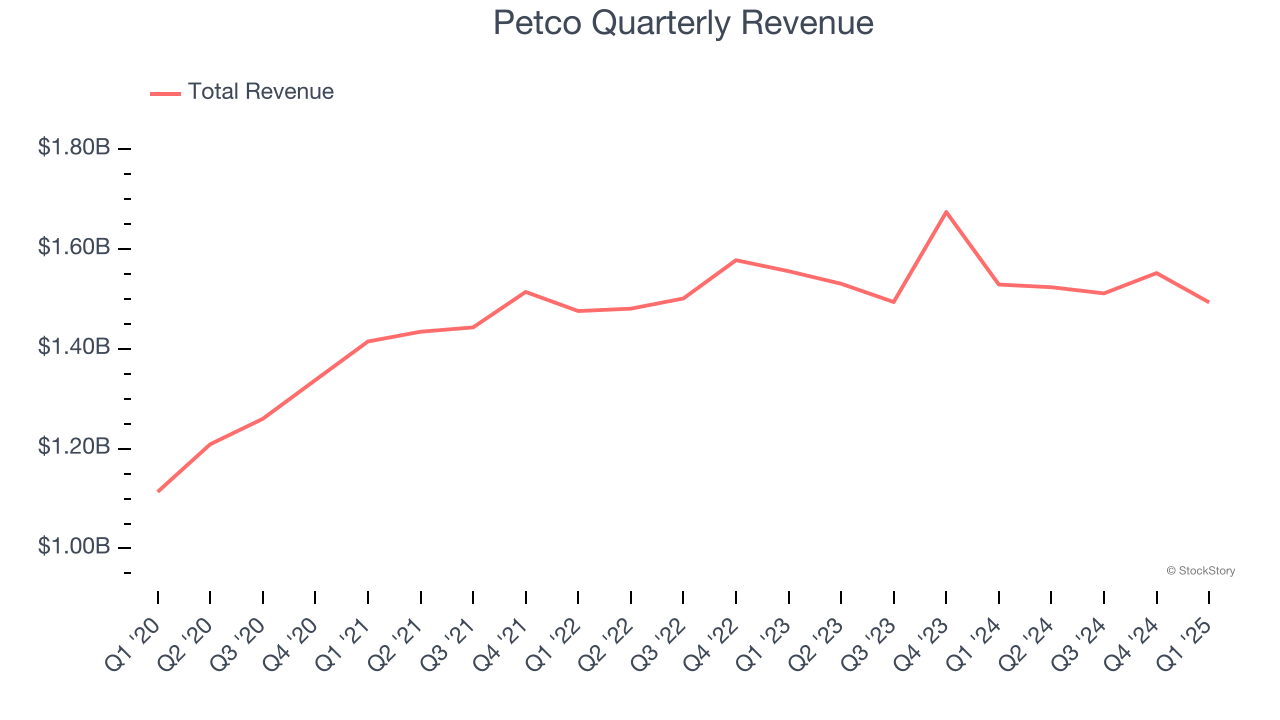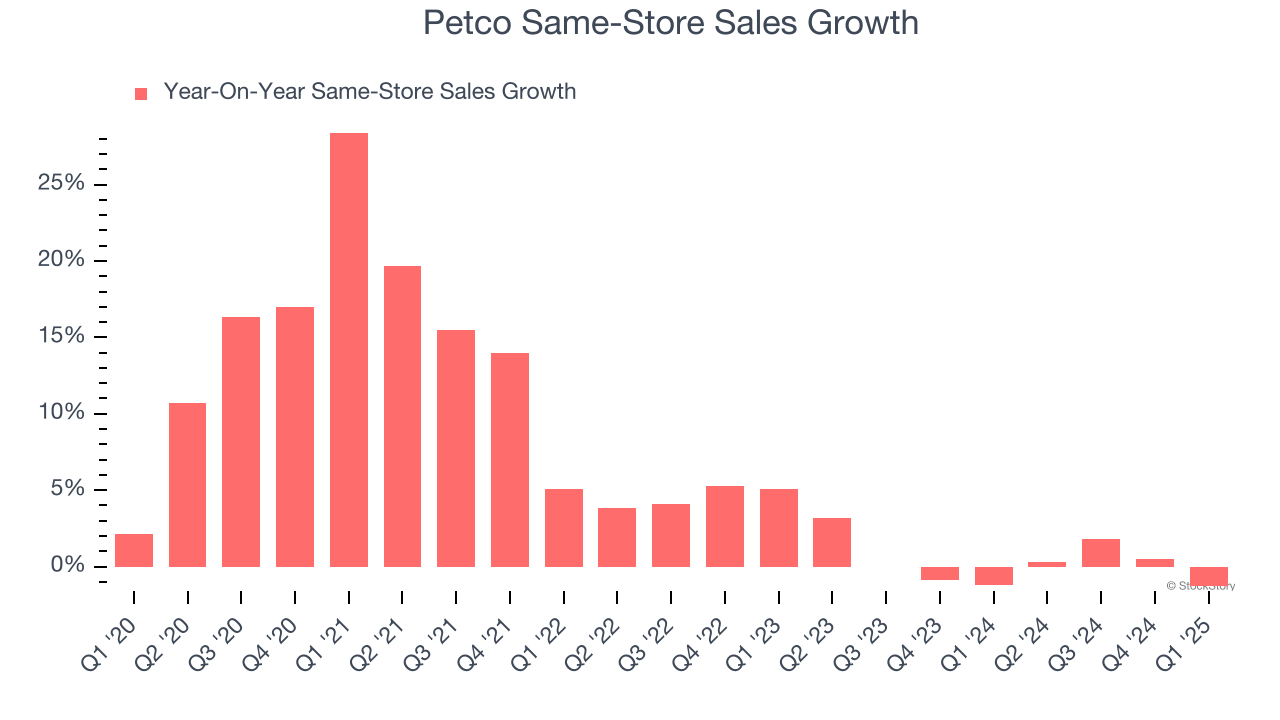
Pet-focused retailer Petco (NASDAQ:WOOF) met Wall Street’s revenue expectations in Q1 CY2025, but sales fell by 2.3% year on year to $1.49 billion. On the other hand, next quarter’s revenue guidance of $1.49 billion was less impressive, coming in 0.8% below analysts’ estimates. Its GAAP loss of $0.04 per share was $0.01 above analysts’ consensus estimates.
Is now the time to buy Petco? Find out by accessing our full research report, it’s free.
Petco (WOOF) Q1 CY2025 Highlights:
- Revenue: $1.49 billion vs analyst estimates of $1.5 billion (2.3% year-on-year decline, in line)
- EPS (GAAP): -$0.04 vs analyst estimates of -$0.05 ($0.01 beat)
- Adjusted EBITDA: $89.45 million vs analyst estimates of $80.68 million (6% margin, 10.9% beat)
- Revenue Guidance for Q2 CY2025 is $1.49 billion at the midpoint, below analyst estimates of $1.50 billion
- EBITDA guidance for the full year is $382.5 million at the midpoint, in line with analyst expectations
- Operating Margin: 1.1%, up from -1.1% in the same quarter last year
- Free Cash Flow was -$43.87 million compared to -$41.06 million in the same quarter last year
- Same-Store Sales fell 1.3% year on year, in line with the same quarter last year
- Market Capitalization: $993.2 million
"We are pleased to deliver first quarter earnings results ahead of our guidance and to reaffirm our outlook for fiscal 2025 which now incorporates the impact of tariffs. This performance is a testament to the execution of our nearly 30,000 team members and the resilience of the category in which we operate," said Joel Anderson, Petco's Chief Executive Officer.
Company Overview
Historically known for its window displays of pets for sale or adoption, Petco (NASDAQ:WOOF) is a specialty retailer of pet food and supplies as well as a provider of services such as wellness checks and grooming.
Sales Growth
A company’s long-term sales performance is one signal of its overall quality. Any business can have short-term success, but a top-tier one grows for years.
With $6.08 billion in revenue over the past 12 months, Petco is a mid-sized retailer, which sometimes brings disadvantages compared to larger competitors benefiting from better economies of scale.
As you can see below, Petco’s sales grew at a tepid 6.4% compounded annual growth rate over the last five years (we compare to 2019 to normalize for COVID-19 impacts) as it didn’t open many new stores.

This quarter, Petco reported a rather uninspiring 2.3% year-on-year revenue decline to $1.49 billion of revenue, in line with Wall Street’s estimates. Company management is currently guiding for a 2.5% year-on-year decline in sales next quarter.
Looking further ahead, sell-side analysts expect revenue to remain flat over the next 12 months, a deceleration versus the last five years. This projection is underwhelming and implies its products will see some demand headwinds.
Here at StockStory, we certainly understand the potential of thematic investing. Diverse winners from Microsoft (MSFT) to Alphabet (GOOG), Coca-Cola (KO) to Monster Beverage (MNST) could all have been identified as promising growth stories with a megatrend driving the growth. So, in that spirit, we’ve identified a relatively under-the-radar profitable growth stock benefiting from the rise of AI, available to you FREE via this link.
Store Performance
Number of Stores
A retailer’s store count influences how much it can sell and how quickly revenue can grow.
Over the last two years, Petco has kept its store count flat while other consumer retail businesses have opted for growth.
When a retailer keeps its store footprint steady, it usually means demand is stable and it’s focusing on operational efficiency to increase profitability.
Note that Petco reports its store count intermittently, so some data points are missing in the chart below.

Same-Store Sales
The change in a company's store base only tells one side of the story. The other is the performance of its existing locations and e-commerce sales, which informs management teams whether they should expand or downsize their physical footprints. Same-store sales gives us insight into this topic because it measures organic growth for a retailer's e-commerce platform and brick-and-mortar shops that have existed for at least a year.
Petco’s demand within its existing locations has barely increased over the last two years as its same-store sales were flat. This performance isn’t ideal, and we’d be skeptical if Petco starts opening new stores to artificially boost revenue growth.

In the latest quarter, Petco’s same-store sales fell by 1.3% year on year. This decline was a reversal from its historical levels.
Key Takeaways from Petco’s Q1 Results
We liked that Petco exceeded analysts’ EBITDA expectations this quarter. We were also glad its EPS outperformed Wall Street’s estimates. On the other hand, both its revenue and EBITDA guidance for next quarter missed Wall Street’s estimates, and this is weighing on shares. The stock traded down 3.8% to $3.51 immediately following the results.
So should you invest in Petco right now? If you’re making that decision, you should consider the bigger picture of valuation, business qualities, as well as the latest earnings. We cover that in our actionable full research report which you can read here, it’s free.
